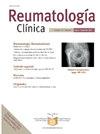建立墨西哥城健康成人血清尿酸的参考值:来自Tlalpan 2020队列的数据
IF 1.3
Q4 RHEUMATOLOGY
引用次数: 0
摘要
尿酸是嘌呤分解代谢的最终产物,其水平与各种心脏代谢疾病有关。在墨西哥,大多数关于准确水平的流行病学数据来自已有合并症的人群,限制了规范性参考值的建立。目的了解墨西哥城健康成人血清尿酸浓度的分布特征。方法采用来自Tlalpan 2020队列的3099名健康成年人(64.6%为女性)的数据进行横断面分析。患有慢性疾病、血压或血糖水平异常或暴露于改变尿酸的药物的参与者被排除在外。记录临床、人体测量和生化参数,并按性别对血清尿酸浓度进行总体和分层分析。结果整个队列的血清尿酸水平中位数为5.16 mg/dL(四分位数范围为4.32 ~ 6.15),中心95%参考区间为3.05 ~ 7.98 mg/dL。中位尿酸水平因性别而有显著差异:女性为4.60 mg/dL(3.99-5.28),男性为6.39 mg/dL(5.61-7.09)。在整个队列中,高尿酸血症的患病率为16.5%,男性(28.4%)明显高于女性(10.0%)。结论:本研究建立了墨西哥健康成人血清尿酸盐的性别特异性参考值。这些发现可能会为临床决策和未来的研究提供准确相关风险分层的信息。本文章由计算机程序翻译,如有差异,请以英文原文为准。
Establishing reference values for serum urate in healthy adults from Mexico City: Data from the Tlalpan 2020 cohort
Background
Urate is the final product of purine catabolism, and its levels have been linked to various cardiometabolic disorders. In Mexico, most epidemiological data on urate levels derive from populations with existing comorbidities, limiting the establishment of normative reference values.
Objective
To characterize the distribution of serum urate concentrations in a healthy adult population residing in Mexico City.
Methods
A cross-sectional analysis was conducted using data from 3099 healthy adults (64.6% women) enrolled in the Tlalpan 2020 cohort. Participants with chronic diseases, abnormal blood pressure or glucose levels, or exposure to urate-altering medications were excluded. Clinical, anthropometric, and biochemical parameters were recorded, and serum urate concentrations were analyzed overall and stratified by sex.
Results
The median serum urate level in the overall cohort was 5.16 mg/dL (interquartile range, 4.32–6.15), with a central 95% reference interval ranging from 3.05 to 7.98 mg/dL. Median urate levels differed significantly by sex: 4.60 mg/dL (3.99–5.28) in women and 6.39 mg/dL (5.61–7.09) in men. The prevalence of hyperuricemia in the total cohort was 16.5%, notably higher in men (28.4%) compared to women (10.0%).
Conclusion
This study establishes sex-specific reference values for serum urate in a healthy Mexican adult population. The findings may inform clinical decision-making and future research on urate-related risk stratification.
求助全文
通过发布文献求助,成功后即可免费获取论文全文。
去求助
来源期刊

Reumatologia Clinica
RHEUMATOLOGY-
CiteScore
2.40
自引率
6.70%
发文量
105
审稿时长
54 days
期刊介绍:
Una gran revista para cubrir eficazmente las necesidades de conocimientos en una patología de etiología, expresividad clínica y tratamiento tan amplios. Además es La Publicación Oficial de la Sociedad Española de Reumatología y del Colegio Mexicano de Reumatología y está incluida en los más prestigiosos índices de referencia en medicina.
 求助内容:
求助内容: 应助结果提醒方式:
应助结果提醒方式:


